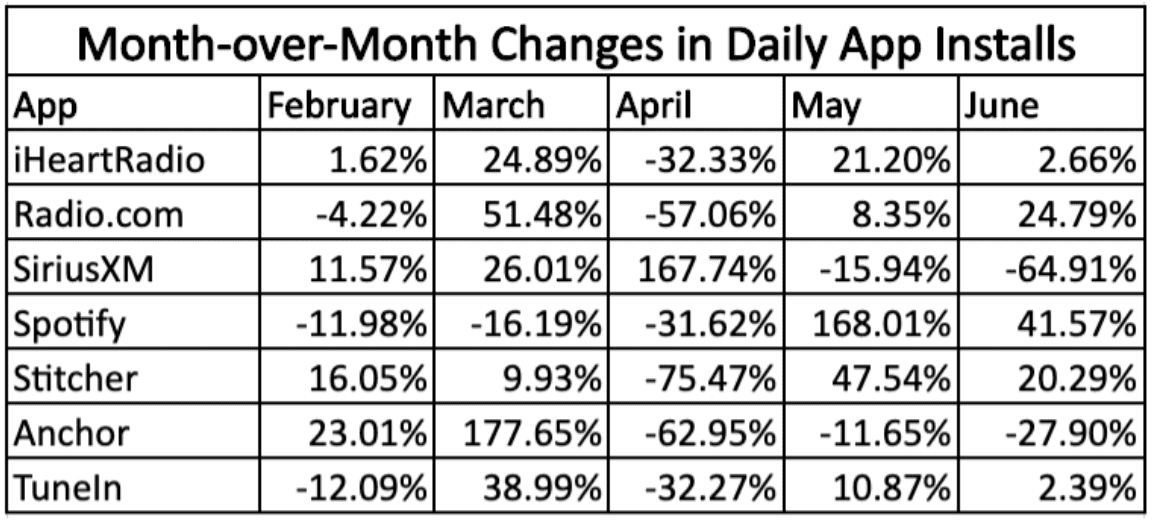- Media Consumption & Trends
- Understanding Consumers
Mobile Music Streaming Apps in 2020: Understanding U.S. Usage

There are now dozens of mobile music streaming apps available in the U.S., ranging from heavy hitters like Google Play Music, Slacker Radio and Amazon Music Unlimited to many more, including dozens of smaller offerings. Some are free while others cost up to $14.99 per month. Some focus on sound quality while, for other apps, other services offered might be music videos, curated playlists, family plans and other bonus features. In short, there are a lot of options to choose from when you want to listen to music, radio broadcasts or podcasts on your mobile device.
But how has use of these app-based music streaming services changed during COVID-19? After all, the common convention holds that most people use these kinds of mobile apps during the commute, either in the car or while on public transportation. This helps to explain why time spent with mobile audio media is expected to stay flat between 2019 and 2020, according to eMarketer.
This is not to say that no one is using these kinds of mobile apps – far from it, in fact. For one, eMarketer noted that the average adult in the U.S. is expected to spend 75 minutes a day on average using mobile audio media. And in polling we conducted in June using InMobi Pulse, InMobi’s mobile market research platform, one in four Americans said they were listening to more music or radio since the Coronavirus outbreak first really began in the country.
But we wanted to dive much deeper into the mobile music streaming app arena. Specifically, we wanted to know which apps were being downloaded this year, when people were seeking out specific apps and who have been downloading these apps since the middle of March. For these insights, we turned to our first-party data sources and looked at seven of the most popular audio streaming apps available now in the U.S.: Anchor.fm, iHeartRadio, Radio.com, SiriusXM, Spotify, Stitcher and TuneIn.
Here’s what we uncovered.
Install Trends of the Top Audio Mobile Apps
During the first three months of 2020, Spotify was the consistent leader among all of the mobile apps we looked at for this effort. This is hardly surprising, as they have become one of the biggest and most well-known audio apps in the country. There are more than 50 million songs on the platform, and Spotify helped to popularize both offline listening and split monetization options (having both a free version with ads and a paid, ad-free option).
Spotify also has seen major gains in new app installs since the end of April. For example, in May Spotify saw over 168% month-over-month growth in daily app installs.
How were they able to see such major gains in the middle of the pandemic? For one, Spotify launched two promotions on May 14, 2020, one targeting new premium activations and another retargeting lapsed premium users.
In addition, this growth is coming off the back of many new podcast-related announcements for Spotify. Since April, Spotify acquired the ever-popular podcast The Joe Rogan Experience and signed podcast-related deals with celebrities such as Kim Kardashian and Michelle Obama.
This, of course, is on top of moves made in 2019 to acquire popular podcast producers like Gimlet and The Ringer. In the podcast department, while Spotify doesn’t yet have a million tracks, it soon will – and its podcast-related moves over the past two years are contributing to the app installs Spotify is seeing while many Americans are staying at home.
Yet despite the strong growth Spotify has seen in 2020, SiriusXM actually had more daily app installs in April and most of the first half of May. In fact, SiriusXM realized well over 167% growth month-over-month in daily app installs in May. On March 31, SiriusXM, which normally does not have a free tier, began offering free streaming on all 300+ channels from April 1 to May 15, 2020.
It will be interesting to see how SiriusXM fares in the rest of the second half of 2020, especially considering that their daily app install numbers fell below what both Spotify and iHeartRadio were seeing in June. On July 13, SiriusXM bought Stitcher to boost their podcast offerings. In June, Stitcher had over 20% growth month-over-month in its daily app install figures.
Stitcher wasn’t the only app we looked at that saw month-over-month growth in June. Radio.com (24.8%), iHeartRadio (2.7%), Spotify (41.6%) and TuneIn (2.4%) all saw gains to some extent in the month.

Who Are Using These Streaming Services Today?
We also wanted to look at who were installing these kinds of apps on their mobile devices in mid 2020. For this effort, we looked specifically at just iHeartRadio, SiriusXM, Spotify, Stitcher and TuneIn.
In terms of gender, this category skews male. Across all of these apps, at least 50% or more of app installers are male. This trend is especially pronounced with TuneIn, where close to 68% of all app owners are male.
Interestingly though, this paints a different picture from what our June survey found. In early June, while 24% of men said they were listening to more music or radio, 27% of women said the same thing.
It’s definitely possible that while this kind of content is popular across both genders, men are more likely than women to use mobile apps to access audio. In addition, it’s also possible that women were already listening, and so are not new listeners.
In terms of age, nearly half of Stitcher's app users are between 26 and 45 years old (42.03%). This will be a change of pace for SiriusXM, which has the highest distribution of users between 46 and 75 years old of all of the apps we looked at, with 63.59% of their users falling into this age range.
Why the difference? SiriusXM is historically associated with car radio, which may help to explain why they do well with this demographic, while many podcasts (where Stitcher specializes) have younger audiences on average.
Beyond these two apps, Spotify has more of its users under the age of 36 while over 25% of iHeartRadio app owners are between 46 and 55 years old. Similarly, more than 45% of TuneIn app owners are between 46 and 65 years old.
Interestingly, the June survey found that 41% of young people (specifically those between 18 and 25 years old) were listening to more music or radio of late, far above what people in other age ranges said. Again, it’s possible that they are either not using apps to listen in or are turning to apps we did not include in this particular analysis, like YouTube Music.
The survey found that people with children at home were more likely than their childless peers to be listening to more radio or music of late. While 22% of those without kids said they were listening to more audio content during the pandemic, 33% of those with kids said the same thing.
On the app ownership front, the bulk of app owners make between $35,000 and $100,000 a year. Spotify has the highest distribution of users with $35,000 and under (potentially leveraging the free, ad-supported option) while Stitcher has the highest percentage of users in every income range above $75,000 in annual income.
Of course, it remains to be seen how these trends will hold out over time. As COVID-19 continues to impact all Americans throughout 2020, it will be interesting to note how adults in the U.S. think about and use mobile apps for listening to music, podcasts and more.
Looking for COVID-19 insights from across the globe? Head to inmobi.com/covid-19 to see how coronavirus has impacted consumer behavior in the Middle East, India, Australia, Indonesia and other parts of the world.
About the Author
Matthew Kaplan has over a decade of digital marketing experience, working to support the content goals of the world’s biggest B2B and B2C brands. He is a passionate app user and evangelist, working to support diverse marketing campaigns across devices. Matt enjoys listening to history podcasts and is a former contributor for music website FasterLouder (now Music Junkee).
Stay Up to Date
Register to our blog updates newsletter to receive the latest content in your inbox.









